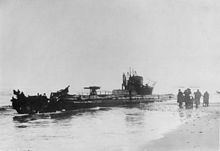Name U-20 Cost 2,450,000 Goldmark Laid down 7 November 1911 Construction started 7 November 1911 Draft 3.58 m | Ordered 25 November 1910 Yard number 14 Length 64 m Launched 18 December 1912 Beam 6.1 m Commissioned 5 August 1913 | |
 | ||
Fate Grounded 4 November 1916 and destroyed by her crew the next day. | ||
SM U-20 was a German Type U 19 U-boat built for service in the Imperial German Navy. She was launched on 18 December 1912, and commissioned on 5 August 1913. During World War I, she took part in operations around the British Isles. U-20 became infamous following her sinking of the British ocean liner RMS Lusitania on 7 May 1915, an act that dramatically reshaped the course of World War I.
Contents
Career
On 7 May 1915, U-20 was patrolling off the southern coast of Ireland under the command of Kapitänleutnant Walther Schwieger. Three months earlier, on 4 February, the Germans had established a U-boat blockade around Great Britain and Ireland and had declared any vessel in it a legitimate target.
At about 13:40 Schwieger was at the periscope and saw a vessel approaching. From a distance of about 700 metres (770 yd) Schwieger noted she had four funnels and two masts, making her a liner of some sort. He recognised her as the Lusitania, a vessel in the British Fleet Reserve, and fired a single torpedo. It hit on the starboard side, almost directly below the bridge. Following the torpedo's explosion, the liner was shattered by a second explosion, possibly caused by either coal dust or a boiler explosion, so large Schwieger himself was surprised. In 18 minutes, Lusitania sank with 1,198 casualties. The wreck lies in 300 feet (91 m) of water.
Fifteen minutes after he had fired his torpedo, Schwieger noted in his war diary:
"It looks as if the ship will stay afloat only for a very short time. [I gave order to] dive to 25 metres (82 ft) and leave the area seawards. I couldn't have fired another torpedo into this mass of humans desperately trying to save themselves."There was at the time and remains now a great controversy about the sinking, over whether Lusitania was smuggling contraband war material to England and over the number of torpedoes Schwieger fired.
Before he got back to the docks at Wilhelmshaven for refuelling and resupply, the United States had formally protested to Berlin against the brutality of his action.
Kaiser Wilhelm II wrote in the margins of the American note, "Utterly impertinent", "outrageous", and "this is the most insolent thing in tone and bearing that I have had to read since the Japanese note last August." Nevertheless, to keep America out of the war, in June the Kaiser was compelled to rescind unrestricted submarine warfare and require all passenger liners be left unmolested.
On 4 September 1915 Schwieger was back at sea with U-20, 85 nautical miles (157 km; 98 mi) off the Fastnet Rock in the south Irish Sea. This rock held one of the key navigational markers in the western ocean, the Fastnet Lighthouse, and any ships passing in and out of the Irish Sea would be within visual contact of it.
RMS Hesperian was now beginning a new run outward bound from Liverpool to Quebec and Montreal, with a general cargo, also doubling as a hospital ship, and carrying about 800 passengers. She was attacked off the Fastnet, a landmark islet in the north Atlantic, off the south-west coast of Ireland. The History of the Great War: The Merchant Navy, Vol. II, by Hurd, reads:
"Only a few days before, Count Bernsdorff, the German Ambassador, had assured the United States government that passenger liners will not be sunk without warning and without ensuring the safety of the non combatants aboard providing that the liners do not try to escape or offer resistance."This time, Schwieger was received with official disgust upon his return to Wilhelmshaven. Ordered to report to Berlin to explain himself, he was required to apologise for having sunk another passenger liner in defiance of a direct order not to do so again. He complained about his treatment in Berlin thereafter.
After his death in 1917, Schwieger was forgiven in Berlin. He received Germany's highest decoration, the Pour le Mérite, having sunk 190,000 tons of shipping.
Fate and legacy
On 4 November 1916, U-20 grounded on the Danish coast south of Vrist, a little north of Thorsminde after suffering damage to its engines. Her crew attempted to destroy her with explosives the following day, succeeding, however, only in damaging the boat's bow (see picture) but making it effectively inoperative as a war ship. The boat remained on the beach until 1925 when the Danish government blew it up in a "spectacular explosion". The Danish navy removed the deck gun and made it unserviceable by cutting holes in vital parts. The gun was kept in the naval stores at Holmen in Copenhagen for almost 80 years. The conning tower was removed and placed on the front lawn of the local museum Strandingsmuseum St. George Thorsminde where it remains today.
Novelist Clive Cussler claims his National Underwater and Marine Agency (NUMA) located the remains of U-20 in 1984, about 400 yards from shore.
